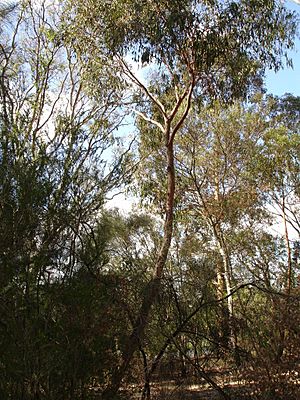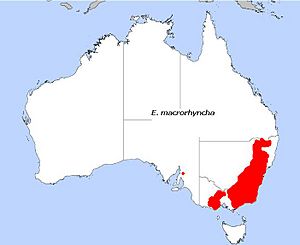Red stringybark facts for kids
Quick facts for kids Red stringybark |
|
|---|---|
 |
|
| Eucalyptus macrorhyncha in Maranoa Gardens | |
| Scientific classification | |
| Genus: |
Eucalyptus
|
| Species: |
macrorhyncha
|
 |
|
| E. macrorhyncha, field distribution | |
The Eucalyptus macrorhyncha, often called the red stringybark, is a medium-sized tree. It is found only in eastern Australia. This tree has rough, stringy bark that is grey to brown. Its adult leaves are shaped like a spear. The tree produces groups of seven to eleven flower buds. These buds open into white flowers. Later, they turn into round, woody fruits.
Contents
What Does It Look Like?
The red stringybark tree usually grows to be about 12 to 35 meters tall. It has a special woody swelling at its base called a lignotuber. This helps the tree regrow after fires. Its bark is rough and stringy, ranging from grey to reddish-brown on the trunk and branches.
Leaves and Flowers
Young plants and new shoots (called coppice regrowth) have egg-shaped leaves. These leaves are about 2.5 to 10.5 centimeters long and 2 to 5.2 centimeters wide. Adult leaves are longer and narrower, shaped like a spear or slightly curved. They are a dull to shiny green on both sides. These leaves are about 7.5 to 14 centimeters long and 1.2 to 3.8 centimeters wide. Each leaf has a small stalk called a petiole, which is about 0.7 to 2 centimeters long.
The flower buds grow in groups of seven, nine, or eleven. They appear where the leaves meet the stem. Each group of buds sits on a main stalk called a peduncle, which is 0.7 to 1.8 centimeters long. Individual buds have smaller stalks called pedicels, about 0.4 to 0.6 centimeters long.
Mature buds are shaped like a diamond. They are about 0.5 to 0.9 centimeters long and 0.4 to 0.5 centimeters wide. Each bud has a beak-shaped cap called an operculum. The tree flowers between February and July, producing white blooms.
Fruit
After flowering, the tree produces a woody fruit. This fruit is shaped like a half-sphere or a flattened sphere. It is about 0.3 to 0.7 centimeters long and 0.6 to 1.2 centimeters wide. The parts that open to release seeds (called valves) stick out above the rim of the fruit.
How It Got Its Name
The red stringybark was officially described in 1867. This description was made by George Bentham. He used samples collected by Frederick Adamson and Ferdinand von Mueller. Mueller had given the tree its name and written about it before. The official description was then published in a book called Flora Australiensis.
Later, in 1973, two scientists, Lawrie Johnson and Donald Blaxell, studied the tree further. They recognized that there were two slightly different types, or subspecies, of the red stringybark. These two types are now accepted:
- One type, Eucalyptus macrorhyncha subsp. cannonii, has larger buds and wider fruit. Its valves stick out more than the other type.
- The other type is Eucalyptus macrorhyncha subsp. macrorhyncha.
Where Does It Grow?
The red stringybark grows in the mountain ranges and high flat areas (tablelands) of New South Wales, the Australian Capital Territory, and Victoria. There is also a small group of these trees living far away from the main population. This small, separate group is found in the Spring Gully Conservation Park in South Australia.
Gallery





